Is no hull the ultimate in sailing?
Published on January 4th, 2022
In a phrase adapted from the Book of Ecclesiastes, the author complains frequently in the book about the monotony of life. The entire passage reads, “The thing that hath been, it is that which shall be; and that which is done is that which shall be done: and there is no new thing under the sun.”
While there are no theologians at Scuttlebutt HQ, a report from nearly fifty years ago explains the thinking that is being applied today to break the world speed sailing record.
When Scuttlebutt published the story about how French kiteboarder Alex Caizergues aims to dethrone Vestas Sailrocket 2’s 2012 record set at 65.45 knots over 500 meters, it sparked the memory of Bill Kreysler who recruited the New York City Public Library research team to find the report for Scuttlebutt.
Published in Scientific American in 1975, author C.L. Stong shared how the ultimate in sailing is a rig without a hull, which is exactly how Caizergues expects to reach 80.99 knots by the end of 2022. Here is the report:
Sailors have long recognized the hull as the chief impediment to speed in a racing yacht. That being the case, why not omit the hull?
A conventional yacht is propelled by the net force of wind and water acting on the sails and the keel. In contrast, the forces that act on the hull merely keep the yacht afloat, meanwhile abstracting some of the energy provided by the wind.
Even for highly streamlined yachts, such as contenders in the America’s Cup races, most of the power of the wind is spent by the hull to stir the water. The hull functions merely as a rigid link that ties the sail to the keel (and also carries the crew).
Such chores might better be assigned to a more efficient device. A few years ago J. G. Hagedoorn (Wijttenbachweg 43, 2407 Oegstgeest, the Netherlands) set out to contrive the ultimate sailing machine: a yacht that requires no hull. Hagedoorn, who is professor of geophysics at the University of Leiden, describes the development of the system as follows:
———————-
 The most important criterion for the quality of any sailboat is its performance in sailing closehauled into the wind. A vertical plane contains the four main resultant forces of the wind and water [see illustration at right].
The most important criterion for the quality of any sailboat is its performance in sailing closehauled into the wind. A vertical plane contains the four main resultant forces of the wind and water [see illustration at right].
The force of the wind (A) on the sail can be regarded as acting at a single point. An opposing force (W) in the same plane effectively acts at a single point on the keel. The two forces A and W are displaced, forming a couple not unlike a seesaw.
This turning moment is opposed by the forces of buoyancy (B) and weight, or mass (M), that are generated by the hull in response to gravity. These two forces also lie in the plane of A and W. The centers at which B and M act are displaced to form a couple that opposes the moment of the couple formed by A and W.
In normal operation the boat heels (tilts to leeward) to the point at which the vector sum of the moments generated by the couples of A and W and B and M equals zero. The sail makes an angle with respect to the direction of the wind. The keel makes a different angle with respect to the motion of the boat through the water.
A force that arises from the deflection of air and water by the sail and the keel drives the boat to the speed at which the opposing force of drag induced by the hull equals the driving force. Drag thus limits the speed of the craft.
The simple picture of the two opposing couples was chosen to illustrate their essential difference.
The buoyancy and the weight of the craft are constant forces. As the boat heels the center of buoyancy moves to leeward because of the width of the beam and the shape of the hull. The center of weight is determined in part by the inclination of the keel, which contains some of the mass. The center of weight can also be altered by shifting the position of the crew. The perpendicular distance between the centers of buoyancy and weight (B and M) is severely limited.
On the other hand, the couple formed by the wind and the water acting on the keel (A and W) depends on the strength of the wind and the resultant movement of the yacht through the water. For every sailboat of this type there is an optimal wind in which use can be made of an optimal couple between buoyancy and weight to achieve maximal performance. Crews of small sailboats demonstrate the optimal couple when they stretch as far as possible from the windward gunwale.
The essential difference between these two couples explains why large boats are faster than small ones.
For example, increasing the linear dimensions of a sailboat 10 times might be supposed to result in a craft that would sail just about the same as it did before the modification. The area of the sails and the area of the drag-generating hull and keel would each have been increased by a factor of 100.
However, both the weight and the buoyancy would have been increased by a factor of 1,000. As a result the proportion of the speed-determining area of the sail and the keel would be increased by a factor of only 10.
Innumerable other factors influence the relative performance of sailboats: cross section, aspect ratio (length to width) of sail and keel, shape of the hull, smoothness of the hull and so on. The frustrating fact, however, is that mass and money must always win.
The small, lively sailboat dashing along in a smother of spray, with the expert sailor balancing to windward on an outboard trapeze, is inexorably overtaken by the comfortably large and sedately moving yacht.
The proa, the catamaran and the trimaran are all successful attempts to increase the arm of the couple formed by the buoyancy and the weight. In principle the catamaran and the trimaran have been fitted out respectively with one boat and two boats too many. In all but relatively calm seas destructive couples arising from wave motion can develop in multiple-hull craft.
 In contrast, the proa represents an almost ideal method of increasing in a small boat the length of the arm of the mass-buoyancy couple. This remarkable little vessel, which resembles a long but narrow canoe fitted with a triangular sail and a slender outrigger to windward, was developed hundreds (perhaps thousands) of years ago by natives of the Mariana Islands.
In contrast, the proa represents an almost ideal method of increasing in a small boat the length of the arm of the mass-buoyancy couple. This remarkable little vessel, which resembles a long but narrow canoe fitted with a triangular sail and a slender outrigger to windward, was developed hundreds (perhaps thousands) of years ago by natives of the Mariana Islands.
The length of the arm of the mass-buoyancy couple is increased when a crewman, preferably a heavy one, moves out along the outrigger. The vessels were first described to the Western world in 1521 by a member of Magellan’s crew. The little boats flitted along at speeds on the order of 30 kilometers per hour, approaching the velocity of the wind.
Nonetheless, European sailors were not impressed. Evidently they preferred their slow, unwieldy boxes to the heathen contraptions. It is astonishing to me that no one, including the Polynesians south of the Marianas, realized that the secret of the ultimate sailing craft can be derived from the proa.
The hull of the proa requires no inherent lateral stability. Stability is provided by the outrigger and its living weight. The hull can be as long and slender as wished. What is not generally realized is that a body of this shape requires an amazing amount of correction by a fin or a rudder to keep it going straight.
No hint of the difficulty of the art of steering such a craft is suggested by a Papuan happily paddling along. However, when an amateur tries to operate such a craft, the hollowed log inexorably turns sideways. No amount of frantic paddling can prevent it from ramming a mudbank.
The beginner must acquire through diligent practice an instinctive knack of flicking the paddle to create rudder action that anticipates the sideways motion and counteracts it before it starts. To keep a long, slender body aligned in a desired direction requires either an active rudder or some stabilizing couple.
The stabilizing couple in a sailboat can be provided by forces that act on the sail and the keel. Some boats can be adjusted to sail stably on a given course with the rudder in a fixed position. A boat with a centered keel is easier to adjust to this mode than one with leeboards. A ‘luffboard’ could be expected to work even better.
The logical conclusion is that the best position for the keel is at the end of a windward outrigger. This takes the trickiness out of the proa. Moreover, the live ballast can be dispensed with because the keel can be shaped to generate a force that opposes the part of the wind force that tends to tip the boat and lift the keel from the water.
It turns out that the required keel has the shape of a curiously curved symmetrical dagger, for which I have coined the name ‘hapa,’ primarily because it sounds Polynesian. The hapa is supported by two outrigger arms that pivot on vertical axes at both ends so that the orientation of the hapa with respect to the hull can be varied by changing the length of the lines connected to both ends of the boat [see illustration at right]. This linkage system enables the crew to alter the hapa’s angle of attack as required by the strength of the wind.
As in the proa, the hull and the sail are symmetrical fore and aft. The hapa is similarly symmetrical. The craft can sail equally well in either direction, with outrigger always to windward.
The Mariana Islands, where the proa was developed, lie roughly at right angles to the prevailing westerly wind. Inter-island traffic moves essentially north and south. To return from a voyage native crews simply reverse their sitting positions instead of turning the proa around.
 Although natives of the Marianas were content with a boat designed to sail north and south, most of the rest of us insist on sailing in any direction we please. Changing course with a boat employing a hapa as an outrigger might be exciting in a strong wind. The outrigger assembly is a restraining device, but the actual villain is the boat. It cannot move sideways easily.
Although natives of the Marianas were content with a boat designed to sail north and south, most of the rest of us insist on sailing in any direction we please. Changing course with a boat employing a hapa as an outrigger might be exciting in a strong wind. The outrigger assembly is a restraining device, but the actual villain is the boat. It cannot move sideways easily.
Instead of ‘going through the wind’ in tacking to windward, it would doubtless be best to pull the hapa to its new position and simultaneously let the sheet go at the mast so that the triangular sail would turn broadside and stop the boat. The other sheet would then be tightened near the foot of the mast, after which the sheet that is now aft would be pulled to set the new course.
It is quite probable that the first time this maneuver was attempted in a strong wind the whole thing would capsize at the precise moment the hapa reversed direction.
As I have mentioned, the connection between the hapa and the boat through the pair of rigid arms constitutes an unsatisfactory restraint. Why not replace the outrigger by a flexible system of lines? One problem is that to make the hapa behave as one wished would require so many guy ropes that their induced drag would be prohibitive.
The idea of a hapa on a flexible leash was so attractive, however, that I could not resist the temptation to redesign it. The new hapa would have to resemble a paravane, which is the underwater kite employed in minesweeping.
It turned out to be frustratingly difficult to design a hydrodynamically efficient hapa that can be pulled on a line. The contraption must follow a stable course just below the surface of the water, a problem that is more difficult than stabilizing a kite because the hapa must operate within the zone of radical transition from water to air.
My first experimental models either jumped out of the water or dived to the bottom, even at walking velocities. It became obvious that a solution might lie in the elimination of cramping restraints. (Recognition of this principle made practical machines of helicopters.)
Pursuit of this concept eventually resulted in a well-behaved hapa, at least through the anticipated range of running speeds. It includes a dish-like hydrofoil resembling a shallow meniscus lens supported by a rigid shaft on which the lens is free to turn [see illustrations at left]. The hapa can never exert a couple, even if it strikes an obstruction.
Although this arrangement is attractive, it imposes drastic limits on the shape of the hapa, which must function effectively as a hydrofoil.
For example, the aspect ratio of a disk cannot exceed unity, whereas the hapa developed for hulls and rigs of the proa type may have an aspect ratio of 4:1 or even 5:1. The complete hapa includes the lens-like hydrofoil and the haft, or shaft, attached to a torpedo-shaped float fitted with a tail fin. The assembly is towed by a bridle.
The principal parts are made of epoxy reinforced by fiberglass. The hollow lens fills with water. Its buoyancy is essentially neutral in both fresh water and salt water. The haft is mounted in a double-race ball bearing and can turn freely around the axis of symmetry of the lens. The fulcrum point at the other end of the haft (in the float) was placed about 5 percent forward of the axis of the lens for maximum pull-to-drag ratio.
The haft takes the place of the three lines that customarily serve to maintain a hydrofoil in the water at the correct angle of attack for the optimum lift-to-drag ratio. It would be possible to support the disk-like member by a bridle of three lines to achieve an essentially unrestrained system, but the scheme would be vulnerable to submerged obstacles. The apparatus would also be somewhat less free to turn.
The chief difficulty of the central haft stems from its required thickness. It must be rigid and strong. The haft of one experimental model measured 1.5 by five centimeters. Its streamlined cross section introduces negligible drag, but it achieves this performance at the cost of symmetry. The haft has the same pernicious preference for traveling broadside to the direction of motion as the Papuan’s dugout.
A compromise must be made between the unacceptable high resistance of a symmetrical (cylindrical) haft and the instability that is introduced by the hydrodynamically ideal cross section. The unavoidable instability is counteracted by the float with its fixed fin. The float also performs the indispensable function of causing the system to operate near the surface.
The weight of the system is equal to half of its totally immersed buoyancy, and the centers of mass and buoyancy are well forward of the point of attachment of the haft to the float. This arrangement results in equal turning couples toward the correct, half-submerged condition, when some random force causes the float to plane up out of the water or to submerge. The towrope is attached to the bridle at a point that causes the axis of the haft to align itself with the rope.
The clumsy-looking device actually behaves better than one might expect. Its pull-drag ratio is about 5:1, and the system is stable up to about 10 kilometers per hour.
This particular hapa can travel in only one direction, but its central plane of symmetry through the axis of the float enables it to be flipped over and so to travel equally well in the reverse direction. This capability may not always be desirable, because an accidental flip-over might result in an awkward situation. For ocean sailing, left-hand and right-band hapas might be safer.
 In the accompanying illustration of the hapa [at right], the boat and the sail are intended merely to depict one of many possible ways of sailing with a hapa that is towed like a kite. The mast does not have the usual stays because the mast-sail system is fully supported by the three lines connecting the three corners to the hapa. A rudder would be useless.
In the accompanying illustration of the hapa [at right], the boat and the sail are intended merely to depict one of many possible ways of sailing with a hapa that is towed like a kite. The mast does not have the usual stays because the mast-sail system is fully supported by the three lines connecting the three corners to the hapa. A rudder would be useless.
A change of course is effected by paying out or pulling in the line at the foot of the mast. In tacking, which involves changing course in such a way as to change the side of the sail the wind hits, the skipper can come about (tack while moving upwind) simply by pulling the hapa in with the front line and at the proper instant launching a second hapa to leeward.
Although I have not tried to jibe (tack while heading downwind), the maneuver could probably be executed by flipping the hapa over and paying out the front line. Both maneuvers could be exciting in a strong wind.
Consider the consequences of introducing the hapa. The boat, always the dominant element in the conventional system of sailing, has been stripped of its keel, rudder, ballast and stays. It has been degraded to the status of a nuisance, contributing to the system little more than instability and undesirable resistance.
The inevitable next step toward developing the ultimate (no hull) system of sailing involves the use of two kites, one in the water and one in the air. The boat is eliminated.
 A large inventory of designs for airborne kites is available for consideration by the experimenter. Only a few of them are efficient and safe enough for carrying a man.
A large inventory of designs for airborne kites is available for consideration by the experimenter. Only a few of them are efficient and safe enough for carrying a man.
It seems incredible that aircraft designers should have been employing sophisticated airfoil sections for more than half a century while specialists in the design of kites and sails have for the most part blindly stuck with thin sections of sheet material. Perhaps the explanation lies in the convenience of stowing and transporting kites that are collapsible.
A major breakthrough was the invention of an inflatable multi-cell airfoil of fabric by D. C. Jalbert of Boca Raton, Florida. The device was subsequently made operationally safe by J. D. Nicolaides, professor of aerospace at the University of Notre Dame. It is called the ParaFoil [see illustration at right]. Its shape, in the form of a rigid, low-speed wing, is maintained entirely by air that enters openings at the leading edge to build up internal pressure.
On landing the Para-Foil, like a conventional parachute, can be collapsed into a manageable bundle of lines and cloth, even in a fairly strong wind. One can also jump with it from an airplane.
Moreover, with the Para-Foil a military flier who has had to abandon his airplane in combat can perform breathtaking evasive maneuvers that are not possible with a conventional parachute. He can also fly horizontally for distances some five times the ejection altitude and can land in stronger winds than is possible with a parachute because he can fly directly into the wind at the moment of landing.
A kite is relatively easy to stabilize for free flight, because the attached weight tends to revert automatically to its correct vertical position below the lifting surface. It is much more difficult to achieve stability when the kite is tethered or towed. The Para-Foil is quite stable, even in the tethered condition. When it is launched correctly, it gains height rapidly and flies stably.
 In the ultimate sailing system, the Para-Foil is tethered to the hapa. The skipper is suspended by a harness, much like the one worn by the pilot of a hang glider [see illustration at right]. The hapa extends to windward and passively takes the direction of the Para-Foil, which is controlled by the yachtsman (who might better be called the ‘aquaviator’).
In the ultimate sailing system, the Para-Foil is tethered to the hapa. The skipper is suspended by a harness, much like the one worn by the pilot of a hang glider [see illustration at right]. The hapa extends to windward and passively takes the direction of the Para-Foil, which is controlled by the yachtsman (who might better be called the ‘aquaviator’).
To turn a Para-Foil and, even more important, to stop it from turning, the yachtsman pulls down on the appropriate webbing of the two webbings attached to the harness. Each webbing has connected to it half of the rear forked shroud lines. I am always impressed by the sensitivity of this control.
This, then, is ultimate sailing: a system that requires the absolute minimum of force-generating surfaces in both air and water.
It is clear that the surfaces of the hapa and the kite must be proportioned so that they are compatible for optimal efficiency to sail within a practical range of wind velocities during tacking, reaching (sailing more or less broadside to the wind) and running before the wind. The proportions are best determined experimentally.
For wind velocities of about 20 kilometers per hour the ND2 (242) Para-Foil, with which I have been experimenting, easily lifts 80 kilograms (177 pounds). It has an aspect ratio of 4:1 and an area of 22.48 square meters (242 square feet).
Beginners should learn to sail with a relatively slow hapa, similar to the one illustrated here. This hapa’s towrope is attached to the bridle at the point where the angle of attack results in the maximum lift-to-drag ratio. It is obviously possible to fix lines to the hapa for altering its angle of attack and thus its velocity.
The advanced student learns to control the hapa so that it tends to occupy a following position on a close-hauled course and a forward position on a reaching or running course.
To attain the forward position the sailor lets the hapa gain on him and then tries to make it run faster by applying more force to the towline at a low angle. In this maneuver the control lines of the Para-Foil must be manipulated in such a way that the sailor almost gets his feet wet.
Both the sail and the hapa in particular are still very much in the first stage of development. A tremendous amount of imaginative thinking, experimenting and designing will have to be completed before the first aquaviator wins a transatlantic sailing race.


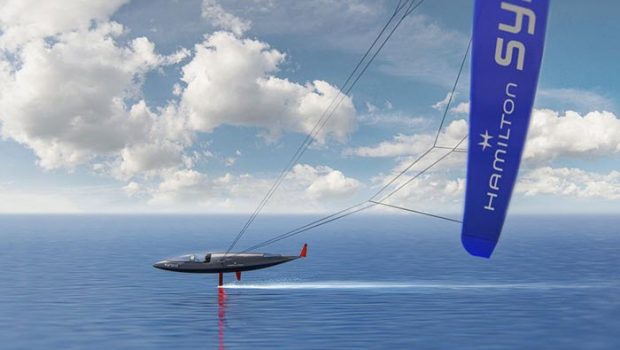


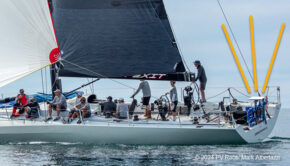
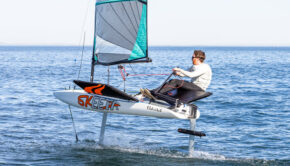
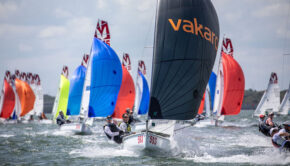
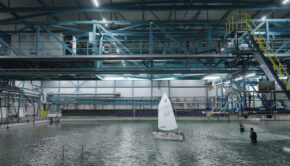
 We’ll keep your information safe.
We’ll keep your information safe.